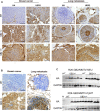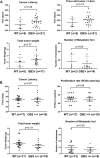Gasdermin-B Pro-Tumor Function in Novel Knock-in Mouse Models Depends on the in vivo Biological Context
- PMID: 35281099
- PMCID: PMC8907722
- DOI: 10.3389/fcell.2022.813929
Gasdermin-B Pro-Tumor Function in Novel Knock-in Mouse Models Depends on the in vivo Biological Context
Abstract
Gasdermins (GSDM) genes play complex roles in inflammatory diseases and cancer. Gasdermin-B (GSDMB) is frequently upregulated in human cancers, especially in HER2-amplified breast carcinomas, and can promote diverse pro-tumor functions (invasion, metastasis, therapy-resistance). In particular, the GSDMB shortest translated variant (isoform 2; GSDMB2) increases aggressive behavior in breast cancer cells. Paradoxically, GSDMB can also have tumor suppressor (cell death induction) effects in specific biological contexts. However, whether GSDMB has inherent oncogenic, or tumor suppressor function in vivo has not been demonstrated yet in preclinical mouse models, since mice lack GSDMB orthologue. Therefore, to decipher GSDMB cancer functions in vivo we first generated a novel knock-in mouse model (R26-GB2) ubiquitously expressing human GSDMB2. The comprehensive histopathological analysis of multiple tissues from 75 animals showed that nucleus-cytoplasmic GSDMB2 expression did not clearly affect the overall frequency nor the histology of spontaneous neoplasias (mostly lung carcinomas), but associated with reduced incidence of gastric tumors, compared to wildtype animals. Next, to assess specifically the GSDMB2 roles in breast cancer, we generated two additional double transgenic mouse models, that co-express GSDMB2 with either the HER2/NEU oncogene (R26-GB2/MMTV-NEU mice) or the Polyoma middle-T antigen (R26-GB2/MMTV-PyMT) in breast tumors. Consistent with the pro-tumor effect of GSDMB in HER2+ human breast carcinomas, R26-GB2/MMTV-NEU GSDMB2-positive mice have double breast cancer incidence than wildtype animals. By contrast, in the R26-GB2/MMTV-PyMT model of fast growing and highly metastatic mammary tumors, GSDMB2 expression did not significantly influence cancer development nor metastatic potential. In conclusion, our data prove that GSDMB2 in vivo pro-tumor effect is evidenced only in specific biological contexts (in concert with the HER2 oncogene), while GSDMB2 alone does not have overall intrinsic oncogenic potential in genetically modified mice. Our novel models are useful to identify the precise stimuli and molecular mechanisms governing GSDMB functions in neoplasias and can be the basis for the future development of additional tissue-specific and context-dependent cancer models.
Keywords: Cancer Progression; Gasdermins; novel mouse models; pyroptosis; tumorigenesis.
Copyright © 2022 Sarrio, Rojo-Sebastián, Teijo, Pérez-López, Díaz-Martín, Martínez, Morales, García-Sanz, Palacios and Moreno-Bueno.
Conflict of interest statement
The authors declare that the research was conducted in the absence of any commercial or financial relationships that could be construed as a potential conflict of interest.
Figures






References
-
- Carl-McGrath S., Schneider-Stock R., Ebert M., Röcken C. (2008). Differential Expression and Localisation of Gasdermin-like (GSDML), a Novel Member of the Cancer-Associated GSDMDC Protein Family, in Neoplastic and Non-neoplastic Gastric, Hepatic, and colon Tissues. Pathology 40, 13–24. 10.1080/00313020701716250 - DOI - PubMed
LinkOut - more resources
Full Text Sources
Molecular Biology Databases
Research Materials
Miscellaneous

